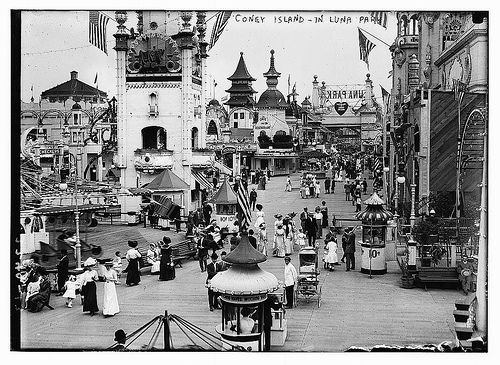

Coney Island's Shore Hotel, at 1230 Surf Avenue. (CC) via Flickr user Whiskeygonebad.
In New York City a debate is raging over how to rebuild one of the America's most storied and iconic neighborhoods -- Coney Island.
Revered as the birthplace of the hotdog and the roller coaster, Coney Island long ago laid claim to America's and the world's imagination. A century ago, Luna Park, Steeplechase and Dreamland provided the template for every amusement park that was follow and in the process reinvented the way Americans experienced leisure.
But Coney Island was more than an incubator of amusement parks. A playground for the masses, it became the resort of last resort for an entire generation of Americans that lived through the Great Depression and staked a claim to a portion of its beach and boardwalk teeming with a million bathers and famously captured in the iconic photographs of Weegee.
After the Second World War, Coney Island underwent a long period of decline that was hastened by the closure of Steeplechase Park in 1964. A few Coney Island landmarks, such as the Cyclone roller coaster, the Wonder Wheel, and Nathan's managed to survive, but in recent years the amusement district has been reduced to a fraction of its former size.
New York City has now embarked on an ambitious plan that promises to transform Coney Island into a year-round tourist destination. The amusement district's revival began with the opening of the new Luna Park at Coney Island on Memorial Day. The park's opening garnered praise for the Bloomberg administration, but the plan for Coney Island's revival has sometimes sparked debate. That debate has now divided some within the historic preservation community.
At issue are several historic buildings on Surf Avenue owned by Coney Island developer Thor Equities. Just as Luna Park was to open its gates, Thor Equities announced it plans to demolish some of the few surviving buildings in the amusement district.
In response, several prominent preservation and advocacy groups -- including the Municipal Arts Society, the New York Landmarks Conservancy, the Historic Districts Council, Coney Island USA, and Save Coney Island -- have called for the endangered buildings to be saved. The proposals submitted to the Landmarks Commission included the creation of a Coney Island Historic District -- a two block long corridor along Surf Avenue that would preserve some of the historic structures.
Preservationists suffered a setback with the news that the application for a Coney Island Historic District would not be considered by the Landmarks Preservation Commission. The commission's staff determined that the buildings did not meet the criteria for designation as an historic district and denied the applicants the opportunity to present their case to the full commission at a public hearing.
In looking only at the "architectural integrity" of the buildings, the Landmarks Commission is missing the larger picture. The significance of the buildings lies in their setting and in the importance of Surf Avenue to Coney Island's history. By allowing the structures to be razed the City risks treating Coney Island as a brand name rather than a place. That would be like Texas tearing down the Alamo to build an Alamo theme park.
Surf Avenue and the nearby Bowery were the core of Coney Island's amusement district. This core district was not defined by its architecture but rather by its honky-tonk flavor: cafes, dime museums, dance halls, and sideshows. Henderson's Music Hall, the Grashorn Building, and the Shore Hotel -- all of which Thor is threatening to demolish -- embody those uses and therefore are architecturally representative of this historically significant amusement district and certainly merit preservation. The Grashorn Building dates back to the 1880s, when Coney Island emerged as the world's pre-eminent amusement mecca. Henderson's is the last surviving example of the music halls that thrived at Coney Island at the turn of the century and were proving grounds for such iconic figures Harry Houdini, Irving Berlin, Jimmy Durante, and the Marx Brothers.
In the past, The Landmarks Commission has granted landmark status to the Cyclone Roller Coaster, the Wonder Wheel and the Parachute Jump, structures that embody Coney Island's contributions to the amusement industry. Surf Avenue played no less a role in the maturation of American popular culture at the turn of the century and the surviving structures merit similar recognition. We cannot help but recall the Landmarks Commission's own history. It was established in the aftermath of the demolition of Pennsylvania Station, a New York City landmark that became iconic only after it was torn down. Let's hope that historic Coney Island does not suffer the same fate.
The groups working to preserve Coney Island believe that the Landmarks Commission can be persuaded to give them a full hearing. Until that happens, the City should withhold the demolition permits Thor Equities will require before it can tear down the buildings. The stakes are high. As Coney Island USA founder Dick Zigun has observed: "There's more left of ancient Rome than turn-of the century Coney Island."

Luna Park, c. 1910. Via the Library of Congress.
A century ago immigrants arriving in New York first glimpsed the towers of Luna Park and Dreamland fretted with electric lights before entering the harbor and catching sight of the Statue of Liberty. Coney Island's place in America's imagination is secure. But historic Coney Island is itself at risk. The few surviving structures must be protected. If preserved, these landmarks of Coney Island's past can become cornerstones of its long awaited revival.